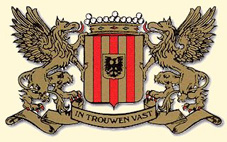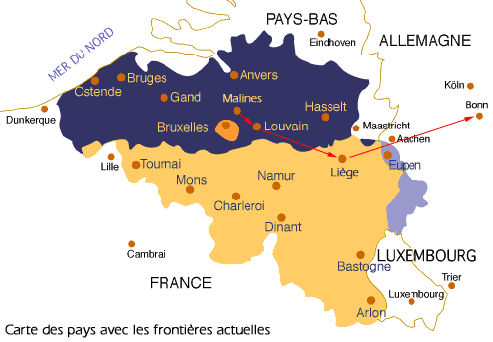| |
|
 |
| |
|
Where does the name van Beethoven come from? Beeth means 'beetroot' and Hoven is the plural of 'Hof', meaning 'farm'. Beethoven is therefore 'beetroot farms'. There is a village named Betthoven in the province of Liège. Early Beethoven History In the 15th century, there were Beethoven’s at Limbourg and at Liège. In the 16th, in many of the Brabant villages: Leefdael, Rotselaer, Bertem, Haecht, Neder Ockerzeel... Then these families moved to towns: Malines, Louvain, Anvers. It was at the end of the 17th and beginning of the 18th centuries that Corneille and his sister Maria arrived at Malines. He was originally from Bertem, his father from Boortmeerbeek and his ancestors from Kampenhout. |
|
|
|
|
|
He was probably a carpenter or joiner. Corneille married Catherine van LEEMPOEL at Malines on February 12, 1673. Corneille van Beethoven was buried in the parish of Notre Dame on March 29, 1716. He was given a middle class funeral and his courtège was escorted down la rue des Pierres by the carpenters’ guild.
|
|
|
|
|
|
In 1700, he was apprentice baker, and became Head Baker on October 5, 1707. He married Maria Ludovica STUYCKERS on October 8, 1707. They moved into a house called The Speckled Bullok. They left in 1711 to live in the Rue des pierres after the death of his father. Michel was therefore a baker, but Beethoven history shows he equally participated in the buying and selling of paintings. Perhaps he could have been a bric-a-brac trader? Around 1720, he worked in the Malines lace trade, particularly reputable for his luxurious items. It would seem that his trade thrived because, in 1727, the Beethoven couple possessed four houses in the rue des Juifs, plus other residences, which each had inherited from their parents. He therefore left Malines probably in March 1741, for Bonn where two of his sons lived. His creditors could not follow him that far... He owed them about 10.000 florins. To put this in perspective, at this time the rent per year for a respectable house was around 50 florins!
|
|
|
|
|
|
Louis was born on January 5, 1712 at Malines. Beethoven’s family included his godfather, Louis Stuyckers, his maternal grandfather, and his godmother Elisabeth van Leempoel, his great aunt. He became a choirboy and then entered the choral school of Saint-Rombaut on December 10, 1717. He was taught by Charles Major, an excellent musician, a demanding teacher and a scholar (at his death he possessed 9 430 works!). After singing, Louis probably learn to play the organ, taught by the organist Antoine Colfs. He showed a strong disposition for music, and indeed his family and he himself thought it would become his profession. |
 |
| However, at Malines, there were few possibilities to make it in life with music. However, the young Louis applied for a job as tenor to the church college of Saint-Pierre, at Louvain, where there was a spare place for a limited period. Not only was he accepted, but the master of the chapel, a certain Louis Colfs (it is not unlikely that he was of the same family as the organist at Malines) proposed to place him as conductor. His knowledge of music and his acquaintances therefore became particularly exceptional. His candidature finished on November 9, 1731. |  |
| In February 1732, Louis left Louvain for Saint-Lambert Cathedral, at Liège, where he sang bass from September 1732 until he departed for Bonn, in March 1733. |  |
|
The Elector Prince of Cologne (Köln), whose court was at Bonn, was archbishop of Cologne but also bishop of Liège. It is therefore probable that he viewed Louis' qualities as valuable, and that this was what led to him having the chance to sing for the court chapel at Bonn. There he refound a fellow countryman with whom he had sung at Liège: van den Aeden. Beethoven history shows that Louis married soon after his arrival in Bonn, to Marie-Joseph POLL, on September 17, 1733. Their witnesses were musicians: The organist Gilles van den Aeden and Jean-Paul Riechler. Despite this post, he took up wine trading to increase his revenues. He became Kapellmeister by decree on July 16, 1761. He wrote numerous works for theatre and opera. Louis died on December 24, 1773. He had lived at Bonn for 40 years. |
 |
|
|
|
|
|
|
As a youngster, he followed lessons at the Jesuite College. Then he became treble at the court chapel, at the age of twelve. Following this, Johann became musician at the court. He married Maria Magdalena KEVERICH on November 12, 1767 at the church of Saint Rémy at Bonn against the wishes of his father. The couple moved into 515 Bonngasse. Johann gave music lessons, usually teaching singing and violin. But drink was the first passion and the first poison of the musician. By 1784, Beethoven history reveals that his voice was completely ruined. He died miserably on December 18, 1792.
|
|
|
| |
 |
Louis, Ludwig's grandfather, is at the heart of the van Beethoven’s family migration. In 1731, he left Malines for Louvain. In 1733, he moved to Bonn after a stay of several months at Liège at the end of 1732. Next, he was joined by his brother Corneille, and then by his parents who were fleeing bankruptcy. |
|
|
| Many
thanks to Hannah SALTER for her translation
of this page from French into English © 2001 - 2013 |
|
||||||||||||||||



